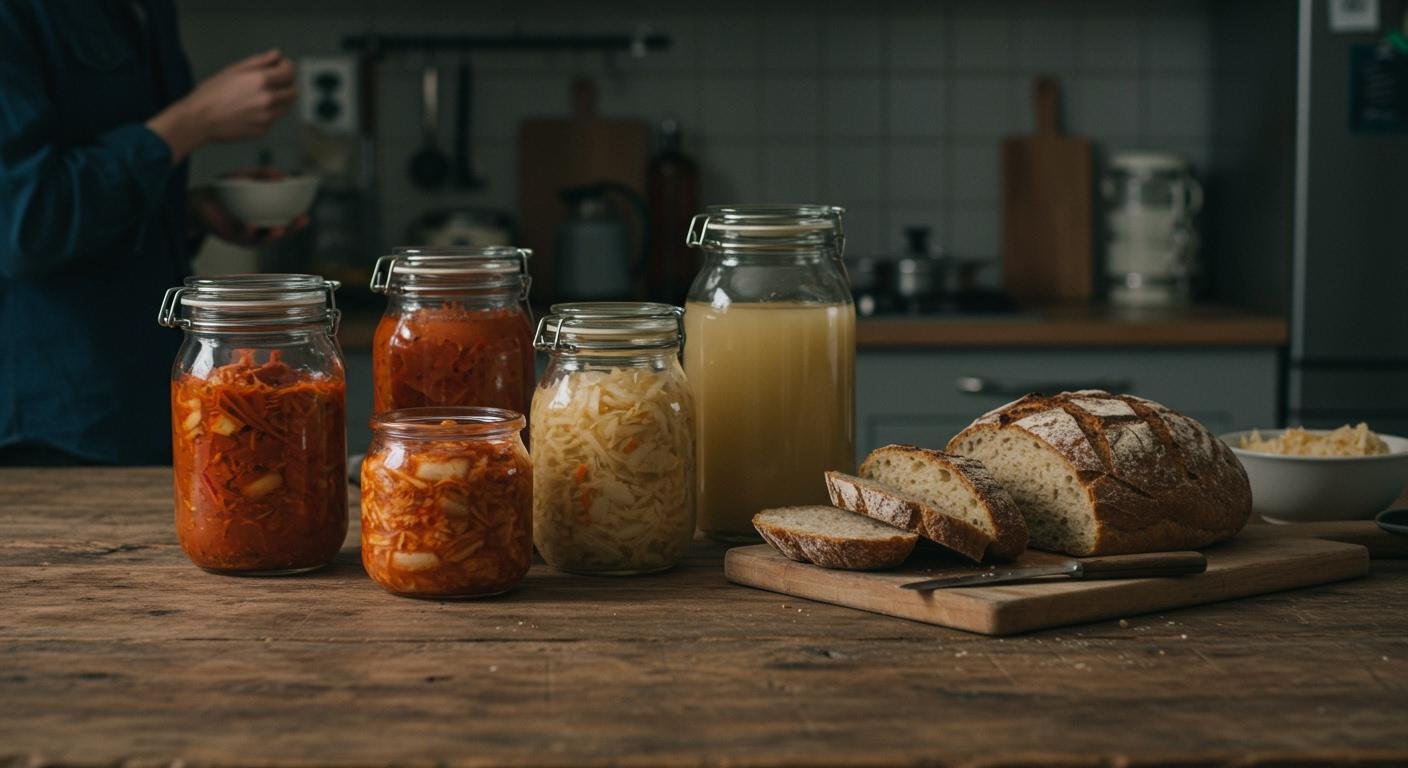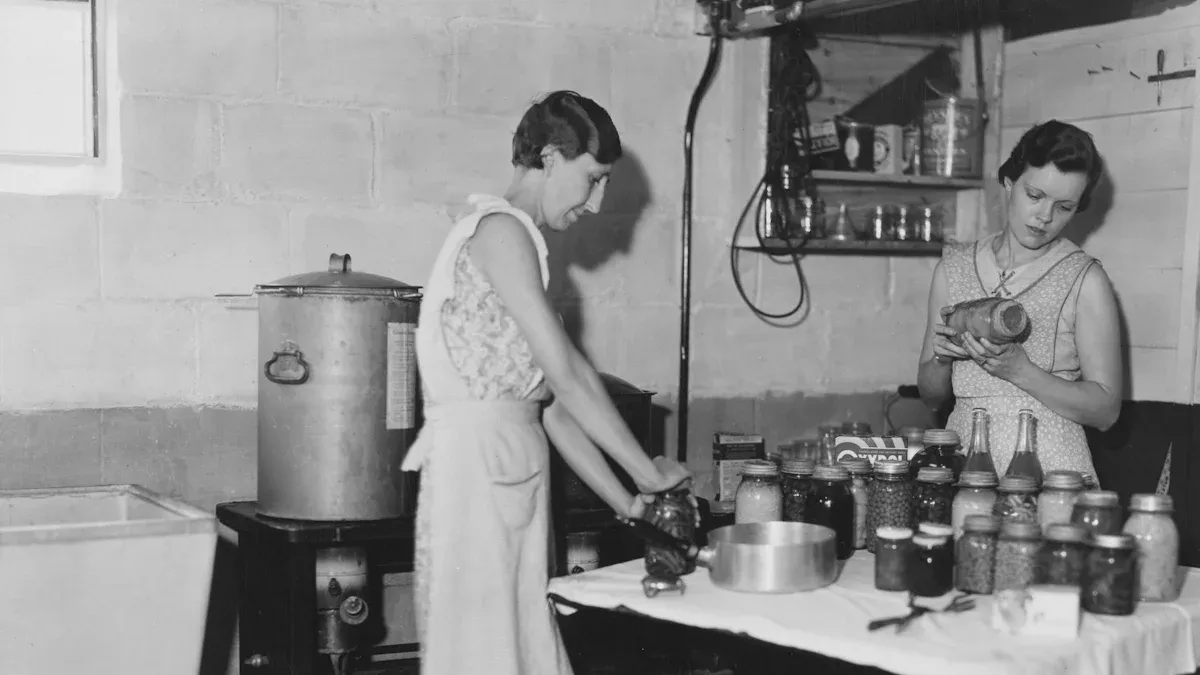Fermentation Entered Western Food Culture
Table of Contents

Fermentation has a rich history as a method of food preservation. The historical significance of fermentation is ancient. Now, a microbial renaissance has begun. This revival happened because of a few key things. People became interested in health. Chefs made fermented foods popular. A cultural shift toward hands-on practices also helped. This is how fermentation entered the modern kitchen.
This trend is supported by several factors:
- A growing interest in DIY and craft culture.
- A desire for personalized, unique flavors.
- The COVID-19 pandemic, which encouraged home-based hobbies.
The global market for fermented products reflects this boom. Fermentation entered kitchens and stores on a massive scale.
| Attribute | Statistics |
|---|---|
| Market Size in 2024 | USD 243.63 Billion |
| Market Forecast in 2033 | USD 383.81 Billion |
| Market Growth Rate (2025-2033) | 4.77% |
How Fermentation Entered the Kitchen

The journey of fermentation into the modern home began with a powerful health movement. People grew more interested in wellness and preventative care. This created a perfect environment for the rise of probiotic-rich foods.
The Gut Health Boom
Scientific research drove public interest in the gut microbiome. Studies showed clear links between fermented foods and positive health outcomes. This new knowledge fueled a demand for products that could improve gut health. The European probiotics market, for example, shows significant growth.
| Region | Projected Value (by 2029) | CAGR (Forecast Period) |
|---|---|---|
| European Probiotics Market | USD 19.4 billion | 5.3% |
Clinical trials provided strong evidence for these benefits. Research demonstrated that regular consumption could lead to:
- Increased gut microbiome diversity
- Decreased markers of inflammation
- Reduced symptoms for conditions like Irritable Bowel Syndrome (IBS)
- A lower risk of type 2 diabetes
This growing body of research gave consumers a compelling reason to add more fermentation into their diets.
From Store-Bought to DIY
Initially, people bought pre-made items like kombucha and sauerkraut. Soon, a do-it-yourself (DIY) spirit took hold. Consumers realized that making these products at home offered significant advantages. Cost was a major factor.
| Product Type | Cost | Quantity |
|---|---|---|
| Homemade Organic Sauerkraut | Less than $3 | 32 ounces |
| Store-bought Organic Sauerkraut | Nearly $10 | 16 ounces |
The shift to home brewing was about more than just saving money. It gave people complete control over ingredients, freshness, and flavor. This hands-on approach to food also reduced packaging waste and supported a more sustainable lifestyle.
Online communities on social media and blogs played a huge role as fermentation entered the home kitchen. These platforms allowed beginners to share recipes, ask questions, and show off their creations. This digital support system made the ancient practice of fermentation feel accessible and exciting for a new generation.
Influential Guides and Chefs

The health movement created demand, but influential figures provided the necessary guidance. Writers and chefs became evangelists. They translated ancient practices for a modern audience. Their work supplied the practical and philosophical knowledge needed for this revival.
Pioneering Books and Guides
Sandor Katz stands out as a central figure in this movement. His book Wild Fermentation offered a simple, accessible approach. It treated fermentation not just as a recipe but as a partnership with microbes. Katz framed the practice as a way to connect with nature and tradition. His follow-up, The Art of Fermentation, won a James Beard Award in 2013, cementing his authority. This shared food knowledge empowered countless home cooks.
The New York Times called Sandor Katz “one of the unlikely rock stars of the American food scene.” His work demystified the process for a generation.
Katz’s teachings transformed a niche hobby into a widespread cultural phenomenon. He provided the foundational knowledge for people to start their own experiments.
Demystifying Fermentation
While Katz inspired home cooks, world-renowned chefs elevated fermentation to gourmet status. Chef René Redzepi of Noma restaurant in Copenhagen led this charge. His kitchen became a famous laboratory for creating complex flavors. Redzepi used fermentation to push the boundaries of fine dining. His team developed unique ingredients, including:
- Hazelnut miso and yellow pea ‘peaso’
- Garums made from beef, bee pollen, and grasshoppers
- Kombuchas flavored with rose and lemon verbena
This innovation showed the world that fermentation was a tool for culinary artistry. Soon, fermentation entered high-end restaurant menus everywhere. Chefs used ingredients like black garlic and house-made garum to create deep, umami-rich flavors. At the same time, food bloggers and video personalities like Brad Leone made the techniques feel fun and achievable. They brought the excitement of the professional food world into home kitchens.
Cultural and Sustainable Shifts
Beyond health benefits and chef endorsements, fermentation aligned with broader cultural movements. People sought greater connection to their food and more sustainable lifestyles. This created the perfect environment for ancient preservation methods to thrive in modern homes.
The Homesteading Revival
A modern homesteading movement gained momentum. People wanted to increase their self-sufficiency and move away from industrial food systems. This revival was driven by a desire for better health, financial savings, and a reduced environmental impact. Fermentation became a cornerstone of this lifestyle. It offered a practical way to preserve homegrown produce and reduce waste.
This hands-on approach to food also helps people feel more prepared and resilient. Many people enjoy making their own sourdough bread, which provides a sense of accomplishment. The skills involved in making bread and other fermented goods build confidence. Learning to make your own bread connects you directly to your food source.
Global Flavors and Community
The fermentation boom also brought people together. The increased availability of global ingredients in grocery stores encouraged home cooks to experiment. Social media platforms made it easy to find fermentation recipes for dishes from around the world. People were no longer limited to local traditions. They could easily try making kombucha, sauerkraut, or kimchi at home.
This shared interest created new communities.
- People gathered for a hands-on workshop to learn new techniques.
- Online groups allowed enthusiasts to share their successes and failures.
- A fermentation workshop became a popular way to gain practical knowledge.
These spaces helped spread food knowledge and made the practice feel less intimidating. This communal sharing of knowledge empowers people to take control of their food and connect with others.
Fermentation entered the modern West through a powerful combination of factors. The gut health movement, influential guides, and a turn toward sustainability created the perfect storm. This ancient tradition now serves multiple purposes. It enhances health, creates complex flavors, and reduces food waste.
This revival of fermentation shows how an old practice can enrich modern home kitchens. It empowers people to take control of their food and connect with others in their community, one kitchen at a time.
FAQ
What is the easiest fermented food to make at home?
Many people consider sauerkraut the easiest fermented food for beginners. It requires only two simple ingredients: cabbage and salt. The process teaches fundamental fermentation principles. This basic food knowledge helps build confidence for more complex projects later on.
Is it safe to make fermented foods at home?
Yes, home fermentation is very safe with the right knowledge. The fermentation process naturally creates an acidic environment. This acidity prevents the growth of harmful bacteria, making the food safe to eat.
Always use clean equipment and fresh ingredients. Following a trusted recipe ensures a successful and safe outcome every time.
What is the main health benefit of eating fermented foods?
The primary health benefit is improved gut health. Fermented foods are rich in probiotics, which are beneficial live bacteria. These microorganisms support a healthy digestive system. They can also help improve nutrient absorption and boost the immune system.
Do I need special equipment to start fermenting?
Most fermentation projects do not require expensive equipment. People can start with basic kitchen items. fermenting.
- Glass jars 🏺
- A kitchen scale
- A weight to keep food submerged
This simple setup is enough for many recipes.

Poseidon
Master of Nutritional Epidemiology, University of Copenhagen, Herbal Functional Nutrition Researcher
Focus: The scientific application of natural active ingredients such as Tongo Ali, Horny Goat Weed, and Maca to sexual health and metabolic regulation.
Core Focus:
Men: Use a combination of Tongo Ali (an energizing factor) + Maca (an energy reserve) to improve low energy and fluctuating libido.
Women: Use a combination of Horny Goat Weed (a gentle regulator) + Maca (a nutritional synergist) to alleviate low libido and hormonal imbalances.
Stressed/Middle-Aged Adults: This triple-ingredient synergy supports metabolism, physical strength, and intimacy.
Product Concept:
Based on traditional applications and modern research (e.g., Tongo Ali promotes testosterone-enhancing enzyme activity, and icariin provides gentle regulation), we preserve core active ingredients and eschew conceptual packaging—using natural ingredients to address specific needs.
Simply put: I'm a nutritionist who understands "herbal actives." I use scientifically proven ingredients like Tongo Ali, Epimedium, and Maca to help you make "sexual health" and "nutritional support" a daily routine.
